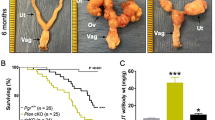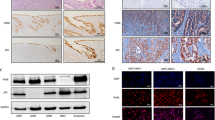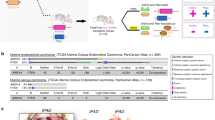Abstract
Type II endometrial carcinomas (ECs) are estrogen independent, poorly differentiated tumors that behave in an aggressive manner. As TP53 mutation and CDH1 inactivation occur in 80% of human endometrial type II carcinomas, we hypothesized that mouse uteri lacking both Trp53 and Cdh1 would exhibit a phenotype indicative of neoplastic transformation. Mice with conditional ablation of Cdh1 and Trp53 (Cdh1d/dTrp53d/d) clearly demonstrate architectural features characteristic of type II ECs, including focal areas of papillary differentiation, protruding cytoplasm into the lumen (hobnailing) and severe nuclear atypia at 6 months of age. Further, Cdh1d/dTrp53d/d tumors in 12-month-old mice were highly aggressive, and metastasized to nearby and distant organs within the peritoneal cavity, such as abdominal lymph nodes, mesentery and peri-intestinal adipose tissues, demonstrating that tumorigenesis in this model proceeds through the universally recognized morphological intermediates associated with type II endometrial neoplasia. We also observed abundant cell proliferation and complex angiogenesis in the uteri of Cdh1d/dTrp53d/d mice. Our microarray analysis found that most of the genes differentially regulated in the uteri of Cdh1d/dTrp53d/d mice were involved in inflammatory responses. CD163 and Arg1, markers for tumor-associated macrophages, were also detected and increased in the uteri of Cdh1d/dTrp53d/d mice, suggesting that an inflammatory tumor microenvironment with immune cell recruitment is augmenting tumor development in Cdh1d/dTrp53d/d uteri. Further, inflammatory mediators secreted from CDH1-negative, TP53 mutant endometrial cancer cells induced normal macrophages to express inflammatory-related genes through activation of nuclear factor-κB signaling. These results indicate that absence of CDH1 and TP53 in endometrial cells initiates chronic inflammation, promotes tumor microenvironment development following the recruitment of macrophages and promotes aggressive ECs.
This is a preview of subscription content, access via your institution
Access options
Subscribe to this journal
Receive 50 print issues and online access
$259.00 per year
only $5.18 per issue
Buy this article
- Purchase on Springer Link
- Instant access to full article PDF
Prices may be subject to local taxes which are calculated during checkout






Similar content being viewed by others
References
Siegel R, Ma J, Zou Z, Jemal A . Cancer statistics, 2014. CA Cancer J Clin 2014; 64: 9–29.
Bokhman JV . Two pathogenetic types of endometrial carcinoma. Gynecol Oncol 1983; 15: 10–17.
Lax SF . Molecular genetic pathways in various types of endometrial carcinoma: from a phenotypical to a molecular-based classification. Virchows Arch 2004; 444: 213–223.
Llobet D, Pallares J, Yeramian A, Santacana M, Eritja N, Velasco A et al. Molecular pathology of endometrial carcinoma: practical aspects from the diagnostic and therapeutic viewpoints. J Clin Pathol 2009; 62: 777–785.
Acharya S, Hensley ML, Montag AC, Fleming GF . Rare uterine cancers. Lancet Oncol 2005; 6: 961–971.
Goff BA . Uterine papillary serous carcinoma: what have we learned over the past quarter century? Gynecol Oncol 2005; 98: 341–343.
Marchetti M, Vasile C, Chiarelli S . Endometrial cancer: asymptomatic endometrial findings. Characteristics of postmenopausal endometrial cancer. Eur J Gynaecol Oncol 2005; 26: 479–484.
Di Cristofano A, Ellenson LH . Endometrial carcinoma. Annu Rev Pathol 2007; 2: 57–85.
Horn LC, Meinel A, Handzel R, Einenkel J . Histopathology of endometrial hyperplasia and endometrial carcinoma: an update. Ann Diagn Pathol 2007; 11: 297–311.
Samarnthai N, Hall K, Yeh IT . Molecular profiling of endometrial malignancies. Obstet Gynecol Int 2010; 2010: 162363.
Ambros RA, Sherman ME, Zahn CM, Bitterman P, Kurman RJ . Endometrial intraepithelial carcinoma: a distinctive lesion specifically associated with tumors displaying serous differentiation. Hum Pathol 1995; 26: 1260–1267.
Soong R, Knowles S, Williams KE, Hammond IG, Wysocki SJ, Iacopetta BJ . Overexpression of p53 protein is an independent prognostic indicator in human endometrial carcinoma. Br J Cancer 1996; 74: 562–567.
Vleminckx K, Kemler R . Cadherins and tissue formation: integrating adhesion and signaling. Bioessays 1999; 21: 211–220.
Huszar M, Pfeifer M, Schirmer U, Kiefel H, Konecny GE, Ben-Arie A et al. Up-regulation of L1CAM is linked to loss of hormone receptors and E-cadherin in aggressive subtypes of endometrial carcinomas. J Pathol 2010; 220: 551–561.
Koyuncuoglu M, Okyay E, Saatli B, Olgan S, Akin M, Saygili U . Tumor budding and E-Cadherin expression in endometrial carcinoma: are they prognostic factors in endometrial cancer? Gynecol Oncol 2012; 125: 208–213.
Moll R, Mitze M, Frixen UH, Birchmeier W . Differential loss of E-cadherin expression in infiltrating ductal and lobular breast carcinomas. Am J Pathol 1993; 143: 1731–1742.
Wu ZY, Zhan WH, Li JH, He YL, Wang JP, Lan P et al. Expression of E-cadherin in gastric carcinoma and its correlation with lymph node micrometastasis. World J Gastroenterol 2005; 11: 3139–3143.
Bremnes RM, Veve R, Hirsch FR, Franklin WA . The E-cadherin cell-cell adhesion complex and lung cancer invasion, metastasis, and prognosis. Lung Cancer 2002; 36: 115–124.
De Marzo AM, Knudsen B, Chan-Tack K, Epstein JI . E-cadherin expression as a marker of tumor aggressiveness in routinely processed radical prostatectomy specimens. Urology 1999; 53: 707–713.
Oka H, Shiozaki H, Kobayashi K, Inoue M, Tahara H, Kobayashi T et al. Expression of E-cadherin cell adhesion molecules in human breast cancer tissues and its relationship to metastasis. Cancer Res 1993; 53: 1696–1701.
Perl AK, Wilgenbus P, Dahl U, Semb H, Christofori G . A causal role for E-cadherin in the transition from adenoma to carcinoma. Nature 1998; 392: 190–193.
Takeichi M . Cadherins in cancer: implications for invasion and metastasis. Curr Opin Cell Biol 1993; 5: 806–811.
Donehower LA, Harvey M, Slagle BL, McArthur MJ, Montgomery CA Jr., Butel JS et al. Mice deficient for p53 are developmentally normal but susceptible to spontaneous tumours. Nature 1992; 356: 215–221.
Harvey M, McArthur MJ, Montgomery CA Jr., Bradley A, Donehower LA . Genetic background alters the spectrum of tumors that develop in p53-deficient mice. FASEB J 1993; 7: 938–943.
Jacks T, Remington L, Williams BO, Schmitt EM, Halachmi S, Bronson RT et al. Tumor spectrum analysis in p53-mutant mice. Curr Biol 1994; 4: 1–7.
Franco HL, Jeong JW, Tsai SY, Lydon JP, DeMayo FJ . In vivo analysis of progesterone receptor action in the uterus during embryo implantation. Semin Cell Dev Biol 2008; 19: 178–186.
Daikoku T, Hirota Y, Tranguch S, Joshi AR, DeMayo FJ, Lydon JP et al. Conditional loss of uterine Pten unfailingly and rapidly induces endometrial cancer in mice. Cancer Res 2008; 68: 5619–5627.
Kim TH, Franco HL, Jung SY, Qin J, Broaddus RR, Lydon JP et al. The synergistic effect of Mig-6 and Pten ablation on endometrial cancer development and progression. Oncogene 2010; 29: 3770–3780.
Reardon SN, King ML, MacLean JA 2nd, Mann JL, DeMayo FJ, Lydon JP et al. CDH1 is essential for endometrial differentiation, gland development, and adult function in the mouse uterus. Biol Reprod 2012; 86: 141–110.
Boussadia O, Kutsch S, Hierholzer A, Delmas V, Kemler R . E-cadherin is a survival factor for the lactating mouse mammary gland. Mech Dev 2002; 115: 53–62.
Derksen PW, Braumuller TM, van der Burg E, Hornsveld M, Mesman E, Wesseling J et al. Mammary-specific inactivation of E-cadherin and p53 impairs functional gland development and leads to pleomorphic invasive lobular carcinoma in mice. Dis Model Mech 2011; 4: 347–358.
Derksen PW, Liu X, Saridin F, van der Gulden H, Zevenhoven J, Evers B et al. Somatic inactivation of E-cadherin and p53 in mice leads to metastatic lobular mammary carcinoma through induction of anoikis resistance and angiogenesis. Cancer Cell 2006; 10: 437–449.
Shimada S, Mimata A, Sekine M, Mogushi K, Akiyama Y, Fukamachi H et al. Synergistic tumour suppressor activity of E-cadherin and p53 in a conditional mouse model for metastatic diffuse-type gastric cancer. Gut 2012; 61: 344–353.
Larue L, Ohsugi M, Hirchenhain J, Kemler R . E-cadherin null mutant embryos fail to form a trophectoderm epithelium. Proc Natl Acad Sci USA 1994; 91: 8263–8267.
Riethmacher D, Brinkmann V, Birchmeier C . A targeted mutation in the mouse E-cadherin gene results in defective preimplantation development. Proc Natl Acad Sci USA 1995; 92: 855–859.
Sherman ME, Bitterman P, Rosenshein NB, Delgado G, Kurman RJ . Uterine serous carcinoma. A morphologically diverse neoplasm with unifying clinicopathologic features. Am J Surg Pathol 1992; 16: 600–610.
Bansal N, Yendluri V, Wenham RM . The molecular biology of endometrial cancers and the implications for pathogenesis, classification, and targeted therapies. Cancer Control 2009; 16: 8–13.
Tuominen VJ, Ruotoistenmaki S, Viitanen A, Jumppanen M, Isola J . ImmunoRatio: a publicly available web application for quantitative image analysis of estrogen receptor (ER), progesterone receptor (PR), and Ki-67. Breast Cancer Res 2010; 12: R56.
Kim MY, Oskarsson T, Acharyya S, Nguyen DX, Zhang XH, Norton L et al. Tumor self-seeding by circulating cancer cells. Cell 2009; 139: 1315–1326.
Klein CA . Parallel progression of primary tumours and metastases. Nat Rev Cancer 2009; 9: 302–312.
Norton L, Massague J . Is cancer a disease of self-seeding? Nat Med 2006; 12: 875–878.
Riethmuller G, Klein CA . Early cancer cell dissemination and late metastatic relapse: clinical reflections and biological approaches to the dormancy problem in patients. Semin Cancer Biol 2001; 11: 307–311.
Dennis G Jr., Sherman BT, Hosack DA, Yang J, Gao W, Lane HC et al. DAVID: Database for Annotation, Visualization, and Integrated Discovery. Genome Biol 2003; 4: P3.
Huang da W, Sherman BT, Lempicki RA . Systematic and integrative analysis of large gene lists using DAVID bioinformatics resources. Nat Protoc 2009; 4: 44–57.
Subramanian A, Tamayo P, Mootha VK, Mukherjee S, Ebert BL, Gillette MA et al. Gene set enrichment analysis: a knowledge-based approach for interpreting genome-wide expression profiles. Proc Natl Acad Sci USA 2005; 102: 15545–15550.
Maxwell GL, Chandramouli GV, Dainty L, Litzi TJ, Berchuck A, Barrett JC et al. Microarray analysis of endometrial carcinomas and mixed mullerian tumors reveals distinct gene expression profiles associated with different histologic types of uterine cancer. Clin Cancer Res 2005; 11: 4056–4066.
Moreno-Bueno G, Sanchez-Estevez C, Cassia R, Rodriguez-Perales S, Diaz-Uriarte R, Dominguez O et al. Differential gene expression profile in endometrioid and nonendometrioid endometrial carcinoma: STK15 is frequently overexpressed and amplified in nonendometrioid carcinomas. Cancer Res 2003; 63: 5697–5702.
Risinger JI, Maxwell GL, Chandramouli GV, Jazaeri A, Aprelikova O, Patterson T et al. Microarray analysis reveals distinct gene expression profiles among different histologic types of endometrial cancer. Cancer Res 2003; 63: 6–11.
Santin AD, Zhan F, Cane S, Bellone S, Palmieri M, Thomas M et al. Gene expression fingerprint of uterine serous papillary carcinoma: identification of novel molecular markers for uterine serous cancer diagnosis and therapy. Br J Cancer 2005; 92: 1561–1573.
Bollrath J, Greten FR . IKK/NF-kappaB and STAT3 pathways: central signalling hubs in inflammation-mediated tumour promotion and metastasis. EMBO Rep 2009; 10: 1314–1319.
Lorusso G, Ruegg C . The tumor microenvironment and its contribution to tumor evolution toward metastasis. Histochem Cell Biol 2008; 130: 1091–1103.
Lu H, Ouyang W, Huang C . Inflammation, a key event in cancer development. Mol Cancer Res 2006; 4: 221–233.
Wu Y, Zhou BP . Inflammation: a driving force speeds cancer metastasis. Cell Cycle 2009; 8: 3267–3273.
Karin M, Cao Y, Greten FR, Li ZW . NF-kappaB in cancer: from innocent bystander to major culprit. Nat Rev Cancer 2002; 2: 301–310.
Li N, Grivennikov SI, Karin M . The unholy trinity: inflammation, cytokines, and STAT3 shape the cancer microenvironment. Cancer Cell 2011; 19: 429–431.
Yu H, Pardoll D, Jove R . STATs in cancer inflammation and immunity: a leading role for STAT3. Nat Rev Cancer 2009; 9: 798–809.
Mantovani A, Sozzani S, Locati M, Allavena P, Sica A . Macrophage polarization: tumor-associated macrophages as a paradigm for polarized M2 mononuclear phagocytes. Trends Immunol 2002; 23: 549–555.
Sica A, Mantovani A . Macrophage plasticity and polarization: in vivo veritas. J Clin Invest 2012; 122: 787–795.
Mazieres J, Brugger W, Cappuzzo F, Middel P, Frosch A, Bara I et al. Evaluation of EGFR protein expression by immunohistochemistry using H-score and the magnification rule: re-analysis of the SATURN study. Lung Cancer 2013; 82: 231–237.
Raes G, Van den Bergh R, De Baetselier P, Ghassabeh GH, Scotton C, Locati M et al. Arginase-1 and Ym1 are markers for murine, but not human, alternatively activated myeloid cells. J Immunol 2005; 174: 6561 author reply 6561–6562.
Scotton CJ, Martinez FO, Smelt MJ, Sironi M, Locati M, Mantovani A et al. Transcriptional profiling reveals complex regulation of the monocyte IL-1 beta system by IL-13. J Immunol 2005; 174: 834–845.
Medvedev AE, Blanco JC, Qureshi N, Vogel SN . Limited role of ceramide in lipopolysaccharide-mediated mitogen-activated protein kinase activation, transcription factor induction, and cytokine release. J Biol Chem 1999; 274: 9342–9350.
Kuhn E, Wu RC, Guan B, Wu G, Zhang J, Wang Y et al. Identification of molecular pathway aberrations in uterine serous carcinoma by genome-wide analyses. J Natl Cancer Inst 2012; 104: 1503–1513.
Berx G, Becker KF, Hofler H, van Roy F . Mutations of the human E-cadherin (CDH1) gene. Hum Mutat 1998; 12: 226–237.
Cleton-Jansen AM, Moerland EW, Kuipers-Dijkshoorn NJ, Callen DF, Sutherland GR, Hansen B et al. At least two different regions are involved in allelic imbalance on chromosome arm 16q in breast cancer. Genes Chromosomes Cancer 1994; 9: 101–107.
Comijn J, Berx G, Vermassen P, Verschueren K, van Grunsven L, Bruyneel E et al. The two-handed E box binding zinc finger protein SIP1 downregulates E-cadherin and induces invasion. Mol Cell 2001; 7: 1267–1278.
Frixen UH, Behrens J, Sachs M, Eberle G, Voss B, Warda A et al. E-cadherin-mediated cell-cell adhesion prevents invasiveness of human carcinoma cells. J Cell Biol 1991; 113: 173–185.
Graff JR, Herman JG, Lapidus RG, Chopra H, Xu R, Jarrard DF et al. E-cadherin expression is silenced by DNA hypermethylation in human breast and prostate carcinomas. Cancer Res 1995; 55: 5195–5199.
Oda T, Kanai Y, Oyama T, Yoshiura K, Shimoyama Y, Birchmeier W et al. E-cadherin gene mutations in human gastric carcinoma cell lines. Proc Natl Acad Sci USA 1994; 91: 1858–1862.
Vleminckx K, Vakaet L Jr., Mareel M, Fiers W, van Roy F . Genetic manipulation of E-cadherin expression by epithelial tumor cells reveals an invasion suppressor role. Cell 1991; 66: 107–119.
Holcomb K, Delatorre R, Pedemonte B, McLeod C, Anderson L, Chambers J . E-cadherin expression in endometrioid, papillary serous, and clear cell carcinoma of the endometrium. Obstet Gynecol 2002; 100: 1290–1295.
Shaco-Levy R, Sharabi S, Piura B, Sion-Vardy N . MMP-2, TIMP-1, E-cadherin, and beta-catenin expression in endometrial serous carcinoma compared with low-grade endometrial endometrioid carcinoma and proliferative endometrium. Acta Obstet Gynecol Scand 2008; 87: 868–874.
Kim JJ, Kurita T, Bulun SE . Progesterone action in endometrial cancer, endometriosis, uterine fibroids, and breast cancer. Endocr Rev 2013; 34: 130–162.
Lindberg ME, Stodden GR, King ML, MacLean JA 2nd, Mann JL, DeMayo FJ et al. Loss of CDH1 and pten accelerates cellular invasiveness and angiogenesis in the mouse uterus. Biol Reprod 2013; 89: 8.
Albini A, Sporn MB . The tumour microenvironment as a target for chemoprevention. Nat Rev Cancer 2007; 7: 139–147.
Karin M . Nuclear factor-kappaB in cancer development and progression. Nature 2006; 441: 431–436.
Coussens LM, Werb Z . Inflammation and cancer. Nature 2002; 420: 860–867.
Grivennikov SI, Greten FR, Karin M . Immunity, inflammation, and cancer. Cell 2010; 140: 883–899.
Heusinkveld M, van der Burg SH . Identification and manipulation of tumor associated macrophages in human cancers. J Transl Med 2011; 9: 216.
Hermani A, De Servi B, Medunjanin S, Tessier PA, Mayer D . S100A8 and S100A9 activate MAP kinase and NF-kappaB signaling pathways and trigger translocation of RAGE in human prostate cancer cells. Exp Cell Res 2006; 312: 184–197.
Moon A, Yong HY, Song JI, Cukovic D, Salagrama S, Kaplan D et al. Global gene expression profiling unveils S100A8/A9 as candidate markers in H-ras-mediated human breast epithelial cell invasion. Mol Cancer Res 2008; 6: 1544–1553.
Reed JR, Leon RP, Hall MK, Schwertfeger KL . Interleukin-1beta and fibroblast growth factor receptor 1 cooperate to induce cyclooxygenase-2 during early mammary tumourigenesis. Breast Cancer Res 2009; 11: R21.
De Palma M, Venneri MA, Galli R, Sergi Sergi L, Politi LS, Sampaolesi M et al. Tie2 identifies a hematopoietic lineage of proangiogenic monocytes required for tumor vessel formation and a mesenchymal population of pericyte progenitors. Cancer Cell 2005; 8: 211–226.
Lin EY, Pollard JW . Role of infiltrated leucocytes in tumour growth and spread. Br J Cancer 2004; 90: 2053–2058.
He G, Karin M . NF-kappaB and STAT3—key players in liver inflammation and cancer. Cell Res 2011; 21: 159–168.
Soyal SM, Mukherjee A, Lee KY, Li J, Li H, DeMayo FJ et al. Cre-mediated recombination in cell lineages that express the progesterone receptor. Genesis 2005; 41: 58–66.
Acknowledgements
We thank Jenny Zadeh at the University of Illinois at Urbana-Champaign Biotechnology Center for microarray analysis. This work was supported by NIH/NCI R15CA179214 and ACS-IL 139038 (to KH), NIH/NICHD R15HD065584 (to JAM) and NIH/NICHD U54HD007495 (to FJD and JPL).
Author information
Authors and Affiliations
Corresponding author
Ethics declarations
Competing interests
The authors declare no conflict of interest.
Additional information
Supplementary Information accompanies this paper on the Oncogene website
Supplementary information
Rights and permissions
About this article
Cite this article
Stodden, G., Lindberg, M., King, M. et al. Loss of Cdh1 and Trp53 in the uterus induces chronic inflammation with modification of tumor microenvironment. Oncogene 34, 2471–2482 (2015). https://doi.org/10.1038/onc.2014.193
Received:
Revised:
Accepted:
Published:
Issue Date:
DOI: https://doi.org/10.1038/onc.2014.193
This article is cited by
-
Development and validation of a nomogram for predicting recurrence-free survival in endometrial cancer: a multicenter study
Scientific Reports (2023)
-
Loss of p53 triggers WNT-dependent systemic inflammation to drive breast cancer metastasis
Nature (2019)
-
Essential genes of the macrophage response to Staphylococcus aureus exposure
Cellular & Molecular Biology Letters (2018)
-
Pancreatic Exocrine Tissue Architecture and Integrity are Maintained by E-cadherin During Postnatal Development
Scientific Reports (2018)
-
Inhibitory effects of Arhgap6 on cervical carcinoma cells
Tumor Biology (2016)



